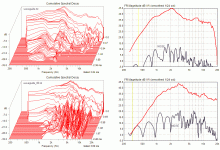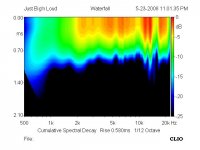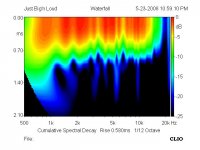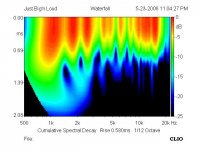The "Starting to regret" part, Earl, I would hope is not on my account.
I expressed my appreciation for you doing it early in this thread....
I expressed my appreciation for you doing it early in this thread....

Hello,
Here are some analyses on the pulse of the waveguide and jbl horn.
Waterfall are multi-resolution time, red=0dB and black<=-40dB, freq is log scal, left waterfall is jblh_00.txt, right is waveguide.txt, no smoothing.
Group delay is calculed with my own routine (max magnitude extraction from the waterfall, max spectrum is also displayed)
Results are close to Jean-Michel Le Cléac'h routine (-dPhi/dW).
I didn't find the group delay as regular as some other waveguide wich minimise diffractions (LeCleach profile, tractrix) however analyses are not necessarily correct and even though it does not mean necessarily a bad listening
Regards,
Avi

Here are some analyses on the pulse of the waveguide and jbl horn.
Waterfall are multi-resolution time, red=0dB and black<=-40dB, freq is log scal, left waterfall is jblh_00.txt, right is waveguide.txt, no smoothing.
Group delay is calculed with my own routine (max magnitude extraction from the waterfall, max spectrum is also displayed)
Results are close to Jean-Michel Le Cléac'h routine (-dPhi/dW).
I didn't find the group delay as regular as some other waveguide wich minimise diffractions (LeCleach profile, tractrix) however analyses are not necessarily correct and even though it does not mean necessarily a bad listening
Regards,
Avi

Hey Avi - your spectrograms are great! Petty wild looking stuff.
Are we seeing noise in this signal? It wasn't taken out, right?
BTW, is it possible to have a spectrogram of the original pulse - the original signal, just for reference? Is the original signal in a file somewhere?
I had a look at you WavArt site. Nice! I'll have to try it out.
Are we seeing noise in this signal? It wasn't taken out, right?
BTW, is it possible to have a spectrogram of the original pulse - the original signal, just for reference? Is the original signal in a file somewhere?
I had a look at you WavArt site. Nice! I'll have to try it out.
gedlee said:Didn't YOU send these to me? And didn't YOU ask me to do this?
Indeed.
gedlee said:Early on, but then you became very biased.
I'm looking back at the thread where this came about:
http://www.diyaudio.com/forums/showthread.php?s=&threadid=122717
You were advocating your waveguide, and an enthusiast suggested EconoWave.
At first, you expressed doubt that JBL could sell a waveguide for $9.90.
They do.
And, you were skeptical that it could play flat.
gedlee said:
That I am skeptical about. I've never seen that in my lifetime. Waveguides and Horns are just never that flat.
I showed you that it did, within your +/- 2 dB criterion.
gedlee said:
Only if they also hold that out to 30°!! Thats the hard part, not on axis, thats easy.
gedlee said:I have measured lots of horns like this I know exactly how it will work. I didn't ask about the off axis response because I didn't know. It will fail to hold control off-axis, I guarantee it.
We sent you EconoWave to measure, and by your own findings, not only does it play flat, just as we said, but it also holds to 30°. Those are the facts.
I suppose I am biased for pointing out that, by comparison, your waveguide does not.
You redefine constant directivity so as to exclude on-axis response (your waveguide cannot meet that requirement,) and you redefine the term "waveguide" itself to exclude diffraction as means to achieve the requisite controlled directivity and power response in favor of the alternative you incorporate in your design.
Further, from your data, more can be done to supress the "resonances" you find in EconoWave response without upsetting its excellent performance in other axes.
I find it patently disingenuous of you to characterize this legitimate alternative perspective on the data as "biased," no less so than your earlier "if you like harsh sound" cheap shot, in the interest of promoting your own viewpoint.
As you suggested earlier, I am trying to have an intelligent discussion of the subject data here, and me being dismissed does not advance this purpose. It is as if there is an alternative agenda.
I am not trashing your design or product, as others have done here; I give little more of a whit about it than you do EconoWave, and there is no basis for you to be offended by me or anything I might say or suggest regarding the facts as you have presented them here.
We are now over 200 posts into this thread, and apparently nobody wants to discuss the actual topic.

ZilchLab said:We are now over 200 posts into this thread, and apparently nobody wants to discuss the actual topic.
Nothing new there.

It's the basic problem of forums like this, you know. We can't HEAR the equipment were discussing over the internet so these threads devolve into silly technical arguments, flying graphs, big and badder math formulas and citation after citation of whatever published works back up the point desired.
It does get tiresome....
Oddly enough, I don't see this sort of ting at audio shows, DIY meets, home get togethers. There is discussion, sure. But not the endless technical bickering. Again, I blame the format. There is just no way to hear what were discussing. Pity, really.
I have heard the JBL waveguide. If I may reiterate:
http://www.diyaudio.com/forums/showthread.php?postid=1517859#post1517859
http://www.diyaudio.com/forums/showthread.php?postid=1517859#post1517859
panomaniac said:
Nothing new there.
It's the basic problem of forums like this, you know. We can't HEAR the equipment were discussing over the internet so these threads devolve into silly technical arguments, flying graphs, big and badder math formulas and citation after citation of whatever published works back up the point desired.
It does get tiresome....
Oddly enough, I don't see this sort of ting at audio shows, DIY meets, home get togethers. There is discussion, sure. But not the endless technical bickering. Again, I blame the format. There is just no way to hear what were discussing. Pity, really.
Regarding the JBL horn.
I suspect it would probably sound better with foam.
I experimented with some elderly exponential horns and the sound was improved remarkably with the foam insert.
Maybe lost max 2dB.
If you like those JBL horns already, you might like them more with the foam....
I suspect it would probably sound better with foam.
I experimented with some elderly exponential horns and the sound was improved remarkably with the foam insert.
Maybe lost max 2dB.
If you like those JBL horns already, you might like them more with the foam....
You suspect what I would like?
Hahaha.
I would "like" to hear the Gedlee horn in a demo.
Who knows...I might then place a deposit.
I am open minded.
Have you heard the Econowaveguide?
Hahaha.
I would "like" to hear the Gedlee horn in a demo.
Who knows...I might then place a deposit.
I am open minded.
Have you heard the Econowaveguide?
FrankWW said:Regarding the JBL horn.
I suspect it would probably sound better with foam.
I experimented with some elderly exponential horns and the sound was improved remarkably with the foam insert.
Maybe lost max 2dB.
If you like those JBL horns already, you might like them more with the foam....
panomaniac said:
It's the basic problem of forums like this, you know. We can't HEAR the equipment were discussing over the internet so these threads devolve into silly technical arguments, flying graphs, big and badder math formulas and citation after citation of whatever published works back up the point desired.
It does get tiresome....
I don't mind the technical blather.
It'd be preferrable if it were regarding relevant data, is all.
We're over 350 posts on AudioKarma, actually.
You guys need to step it up. 😉
Interested parties can find the project summary here:
http://audiokarma.org/forums/showthread.php?p=1856214#post1856214
Is it possible to show the noise for the other wave guide data?
Here you are.
Attachments
Zilchlab
Much of what you say is true and I appologize if I were being unfair.
But I don't see the data the same way that you do.
I didn't redefine the term "waveguide", I defined it in the first place. I first used this term back in 1991 in my paper on "Waveguides". Others have redefined it to include their concepts, not I. You can look this up with no trouble. There is no usage of the term before 1991 until my paper.
You also failed to point out that I explained that the JBL horn was not new and I was chastised that it was their "latest". As it turned out I was right on that one.
Yes, diffraction CAN achieve good directivity control, but it does this in an unacceptable way and that is clearly evident in the data.
To me directivity control means all the way around the device not just in the horizontal plane. The JBL horn does not do that and that was more my point about it not being CD.
Yes, the singular hole in the center of the waveguide - if not EQ'd out - by a strick definition would NOT be CD. But this is far less of a stretch than calling the JBL horn CD. By a very strick deffinition nothing is CD.
The comment about "harsh" is frankly quite true, and you and everyone else knows this. Horns simply tedn to sound harsh. This is exactly what I was trying to solve when I developed the waveguide theory. I have solved this problem and it makes a huge difference. I have been trying to point out in the data how this can be seen, but clearly people can only see what they are looking for.
If you like the JBL horn then by all means continue to use it. I have done more work in this area than anyone that I know of and I am just not happy with diffraction as a device to control sound.
Much of what you say is true and I appologize if I were being unfair.
But I don't see the data the same way that you do.
I didn't redefine the term "waveguide", I defined it in the first place. I first used this term back in 1991 in my paper on "Waveguides". Others have redefined it to include their concepts, not I. You can look this up with no trouble. There is no usage of the term before 1991 until my paper.
You also failed to point out that I explained that the JBL horn was not new and I was chastised that it was their "latest". As it turned out I was right on that one.
Yes, diffraction CAN achieve good directivity control, but it does this in an unacceptable way and that is clearly evident in the data.
To me directivity control means all the way around the device not just in the horizontal plane. The JBL horn does not do that and that was more my point about it not being CD.
Yes, the singular hole in the center of the waveguide - if not EQ'd out - by a strick definition would NOT be CD. But this is far less of a stretch than calling the JBL horn CD. By a very strick deffinition nothing is CD.
The comment about "harsh" is frankly quite true, and you and everyone else knows this. Horns simply tedn to sound harsh. This is exactly what I was trying to solve when I developed the waveguide theory. I have solved this problem and it makes a huge difference. I have been trying to point out in the data how this can be seen, but clearly people can only see what they are looking for.
If you like the JBL horn then by all means continue to use it. I have done more work in this area than anyone that I know of and I am just not happy with diffraction as a device to control sound.
gedlee said:
As a scientist I question everything and am dubiuos about results that cannot be duplicated across a wide variety of people and situations. How can you be so sure that you, as an individual, are correct and the rest of the world, who aren't so dumb either, are wrong? "As a pure egotist audiophile " I guess that I know the answer.
Ah Earl,
Are you??
I have been lurking in your threads for weeks.
In every instance that you are challenged we see the same circular arguments, cop outs and distortion of the facts.
Is this not the Pot called the kettle black?
I think if I threw odds boths ways I could retire in 10 nano seconds.
Skywave-Rider said:Earl,
Thanks for your response.
Referring to the directivity pattern and placement of your product, as designed, I can’t see how the toe-in works in a control room or workstation environment. In those applications computer monitors, meter bridges, and even old fashioned traditional consoles will obscure much of the energy intended to reach the opposite side wall.
Since the AI line is a pro-sound monitor product, how could this be integrated into a typical work environment as described?
And how would you implement same into a 5.1 mix room?
Thanks.
gedlee said:
The control room is not designed to be a good listening space and no speaker will work very well with all that "stuff" in the way. But I would say that these designs will work as good as or better than almost any other monitor speaker that I know of. My Thailand partner was a recording engineer and producer in NY, Tokyo, Bangkok and more. He said that he always wanted monitors like the ESP's but couldn't find them.
Quite honestly Kenny is the expert on control room design, having made several all over the world and I would push your question to him. Write him at kenny.jackel@Ai-audio.com.
My expertise is in listening rooms and home theater. Very different environments.
Earl,
Regardless of your qualifications if we look at the response to this quote how can you expect anyone to go along with everything you say.
This is just a complete misinformation.
iMac
macka said:
Earl,
Regardless of your qualifications if we look at the response to this quote how can you expect anyone to go along with everything you say.
This is just a complete misinformation.
iMac
I don't think so. I have been a lot in studio control rooms. My experience is that typically you get an environment like the bridge of starship Enterprise and a set of big overhanging or inset loudspeakers for your club mix. 80% of mixing is done on meter bridge perched small 2 ways ranging from low fi for translation checks, to Genelec. Most of the times on their (wrong) side. Silly amounts of absorption and zones of hot and dead spots is my typical experience there.
Only places that had nice acoustics were BIG dubbing theaters. Film & TV industry is far more lucrative and uses lots of interesting spaces and tons of top quality equipment.
When I asked Earl to post the impulse data I was hoping I could input it into CLIO. That didn't work out. I wanted to compare his data to 3 horns and a waveguide I had data for. I am curious to see if you can tell which is which from looking at the CSD plots. They break down into an exponential, 2 difraction type horns and a waveguide. Here are the CSD's which is which??
Rob🙂
Rob🙂
Attachments
- Status
- Not open for further replies.
- Home
- Loudspeakers
- Multi-Way
- Horn vs. Waveguide




